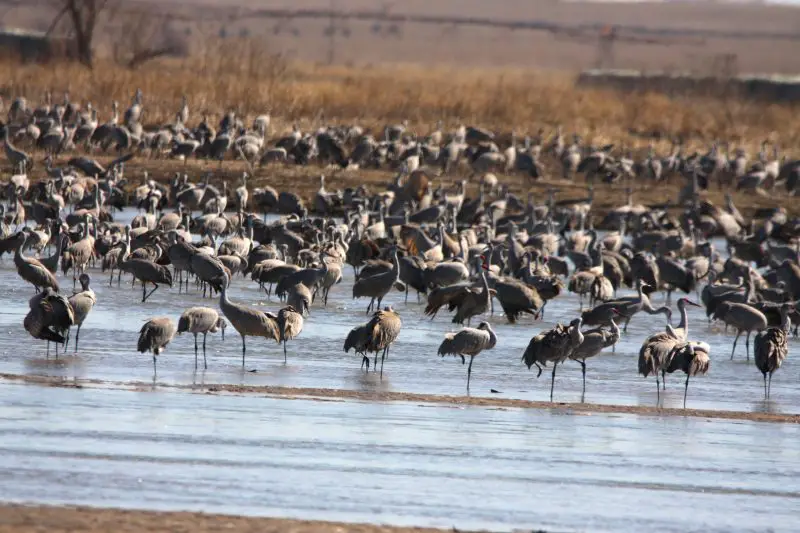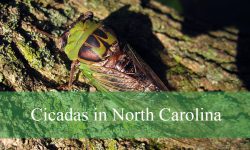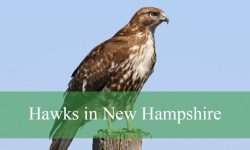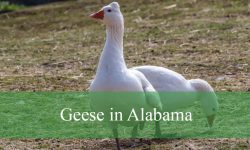Sandhill Cranes are some of the most iconic and fascinating birds in North America. Their graceful appearance and striking calls make them a favorite among bird lovers.
Every year, thousands of these majestic birds gather in Nebraska’s wetlands. This gathering creates a spectacular natural event that draws bird watchers and nature enthusiasts from around the world.
But why do Sandhill Cranes flock specifically in Nebraska wetlands? Understanding this leads us to explore their migration patterns, habitat needs, feeding habits, social behavior, and the unique environment Nebraska offers.
The Migratory Journey of Sandhill Cranes

Sandhill Cranes are migratory birds, traveling thousands of miles twice a year between their breeding grounds in the northern parts of North America and their wintering grounds further south. Nebraska sits at a crucial midpoint along their migratory route, often referred to as the Central Flyway. This flyway is one of the major north-south routes for migratory birds in the Americas.
During spring and fall, Sandhill Cranes stop in Nebraska to rest and refuel before continuing their long journey. The wetlands in this region serve as an ideal pit stop. The timing and geography of Nebraska’s wetlands make it a natural meeting point for these birds to congregate in large numbers.
The Importance of Nebraska Wetlands as Stopover Habitat
Nebraska’s Platte River and associated wetland areas provide essential resources that support the Sandhill Cranes during migration. Wetlands offer food, safety, and space for the cranes to gather. The shallow waters and abundant vegetation create a rich environment filled with nutritious food sources.
The cranes rely heavily on wetlands for foraging because these areas are rich in tubers, roots, insects, and aquatic plants. This diverse diet is crucial for replenishing the birds’ energy reserves. Without such productive wetlands, the cranes would struggle to sustain the energy necessary for migration.
Moreover, wetlands offer protection. The open water and surrounding marshy areas allow the cranes to see predators from a distance and safely roost overnight. The safety provided by these wetlands encourages large groups of cranes to come together in one location.
Social Behavior and Flocking Dynamics of Sandhill Cranes
Sandhill Cranes are highly social birds. Their tendency to flock is tied to their survival strategies and mating behaviors. Gathering in large groups allows the cranes to share information about food availability and dangers in the environment.
Large flocks can also create safety in numbers, reducing individual predation risk. Sandhill Cranes engage in communal behaviors such as synchronized dancing and vocalizing, which strengthen social bonds within the flock. These activities are particularly evident during their time in Nebraska wetlands.
Additionally, these gatherings play a role in courtship and pair bonding. The wetlands become a natural stage for cranes to meet potential mates and engage in elaborate displays. These social interactions are vital for maintaining the species’ population and genetic diversity.
Why Nebraska? The Unique Geography and Climate
Nebraska’s wetlands possess several characteristics that make them uniquely suited for hosting large numbers of Sandhill Cranes. The Platte River Valley features expansive sandbars, shallow waters, and extensive marshes, creating the perfect environment for resting and feeding.
The timing of migration coincides with seasonal water levels in the wetlands, which are influenced by spring runoff and rainfall. These conditions ensure that food is abundant at the exact time the cranes arrive. The wide, open spaces also facilitate the cranes’ need for visibility to detect predators and safe takeoff and landing areas.
Nebraska’s central location within the flyway makes it a convenient crossroads for cranes coming from diverse breeding and wintering areas. This geographic advantage concentrates thousands of birds in the same place, enhancing the flocking phenomenon.
The Role of Human Conservation Efforts
Conservation programs in Nebraska have played a significant role in maintaining the health of wetlands and ensuring safe habitats for Sandhill Cranes. Efforts to preserve the Platte River Valley’s natural state, control water usage, and restore wetland areas have helped sustain the ecosystem that cranes depend on.
Organizations and local communities collaborate to monitor crane populations and protect important stopover sites. Education and ecotourism also raise awareness about the cranes’ importance, generating support for continued conservation.
These efforts have not only benefited the cranes but have also enhanced biodiversity and improved water quality, benefiting many other species and the environment as a whole.
Feeding Habits and Nutritional Needs During Migration
The diet of Sandhill Cranes during their stopover in Nebraska wetlands is varied and tailored to meet their high energy demands. Their feeding strategy focuses on carbohydrate-rich foods that provide quick energy and nutrients essential for migration.
Tubers of aquatic plants like sago pondweed and roots of wild celery are staples. Additionally, cranes forage in nearby agricultural fields for leftover grains such as corn and wheat. This mix of natural and agricultural food sources offers balanced nutrition.
The cranes spend many hours feeding each day to accumulate fat reserves. These fat stores are crucial to sustain long flights and endure periods of scarce food elsewhere along the migration path.
The Spectacle of Sandhill Crane Migration: A Cultural and Ecological Treasure
The annual congregation of Sandhill Cranes in Nebraska wetlands is more than just a biological event; it is a cultural celebration and a powerful symbol of nature’s rhythms. For residents and visitors alike, the sight of thousands of cranes calling, dancing, and taking flight is awe-inspiring.
This spectacle has fostered a strong connection between people and wildlife, encouraging ecotourism and local economies. It also serves as an indicator of wetland health, as changes in crane numbers can signal environmental shifts.
The cranes’ presence highlights the importance of protecting migratory bird routes and wetland ecosystems in a rapidly changing world.
Challenges Facing Sandhill Cranes and Their Wetland Habitats
Despite the importance of Nebraska’s wetlands, Sandhill Cranes face ongoing threats that could impact their traditional flocking behaviors. Habitat loss due to agricultural expansion, water diversion, and urban development puts pressure on critical stopover sites.
Climate change introduces unpredictable weather patterns that affect wetland water levels and food availability. These environmental changes could disrupt the cranes’ migration timing and success.
Continued conservation and adaptive management are essential to mitigate these threats and ensure that Nebraska wetlands remain a safe haven for Sandhill Cranes and other wildlife.
Frequently Asked Questions About Sandhill Cranes in Nebraska Wetlands
Why do Sandhill Cranes choose Nebraska wetlands during migration?
Sandhill Cranes select Nebraska wetlands because these areas provide abundant food, safe resting spots, and ideal water conditions needed to refuel during their long migratory journey. Nebraska’s location along the Central Flyway also makes it a natural stopover point.
What do Sandhill Cranes eat while stopping in Nebraska?
During their stopover, Sandhill Cranes feed mainly on tubers and roots of aquatic plants found in wetlands. They also forage in nearby agricultural fields, consuming leftover grains such as corn and wheat to build energy reserves for migration.
How large can Sandhill Crane flocks get in Nebraska?
Flocks can number in the tens of thousands, especially during peak migration seasons in spring and fall. This mass gathering is one of the largest concentrations of Sandhill Cranes in North America.
Are Nebraska wetlands protected for Sandhill Cranes?
Yes, many wetlands in Nebraska are protected through conservation programs that maintain habitat quality, control water flow, and promote wetland restoration to support Sandhill Cranes and other wildlife.
When is the best time to see Sandhill Cranes in Nebraska?
The best time to observe Sandhill Cranes is during their migration periods, typically from late February through April in spring and from late September to November in fall when the largest flocks gather.
Do Sandhill Cranes breed in Nebraska wetlands?
Nebraska wetlands are primarily used as stopover sites during migration. Sandhill Cranes usually breed further north in states like Montana, Wyoming, and Canada, where they nest in remote wetlands.
What threats do Sandhill Cranes face in Nebraska?
Major threats include habitat loss due to agriculture and urban development, water management issues affecting wetlands, and climate change which can alter migration timing and food availability.
How can people help protect Sandhill Cranes and their habitats?
Supporting wetland conservation efforts, promoting sustainable water use, and raising awareness about the importance of migratory bird habitats help protect Sandhill Cranes. Responsible ecotourism also contributes positively by funding conservation.
Conclusion: The Interconnectedness of Sandhill Cranes and Nebraska Wetlands
The phenomenon of Sandhill Cranes flocking in Nebraska wetlands is the result of a complex interplay between migratory behavior, ecological needs, social dynamics, and environmental conditions. Nebraska’s wetlands provide the perfect combination of food, safety, and geography that supports thousands of cranes during their arduous journey.
This gathering is a testament to the resilience of nature and the critical role that well-preserved habitats play in sustaining migratory species. Protecting these wetlands ensures that future generations can continue to witness the breathtaking sight of Sandhill Cranes soaring above Nebraska’s skies.






